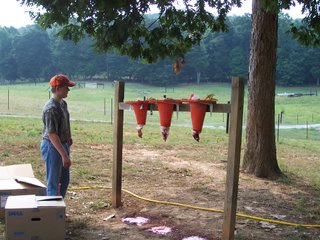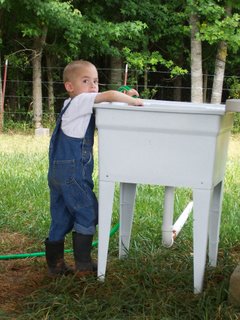 Step one: Catching the chicken!!! We brought these stinky things from their tractor out to the barn area, a.k.a., the processing plant, using three large computer boxes and a diesel-powered mule.
Step one: Catching the chicken!!! We brought these stinky things from their tractor out to the barn area, a.k.a., the processing plant, using three large computer boxes and a diesel-powered mule. Step two: A couple of the boys were especially eager to kill some Cornish Cross birds. I was all for that; it meant I didn't have to do that part (that's a good thing)! We had three traffic cones that the guys putting in our city water had left; we put them to good use by cutting off the tops and hanging them upside down. This was for easier killing of the chicken, and to hold them still while they were bleeding to death!
Step two: A couple of the boys were especially eager to kill some Cornish Cross birds. I was all for that; it meant I didn't have to do that part (that's a good thing)! We had three traffic cones that the guys putting in our city water had left; we put them to good use by cutting off the tops and hanging them upside down. This was for easier killing of the chicken, and to hold them still while they were bleeding to death! Step three: "Cut off its head and give the bird to me, please!" Yep, we cut off their heads before we scalded them. We threw the heads into the woods and the cats loved them!
Step three: "Cut off its head and give the bird to me, please!" Yep, we cut off their heads before we scalded them. We threw the heads into the woods and the cats loved them!"No! That one's not been through yet! Don't cut off the feet!" We learned that it's very hard to take a chicken out of the scalder without any feet to grab.
 Step four: The actual scalding was quite easy. I have never noticed any of that "horrid wet feather smell" I've heard talked about, but they were rather heavy to take out all hot and dripping wet!
Step four: The actual scalding was quite easy. I have never noticed any of that "horrid wet feather smell" I've heard talked about, but they were rather heavy to take out all hot and dripping wet!Sometimes the tongs worked to take the bird out; sometimes they didn't.I mainly used them to push the bird down in the 150°F water. We kept the birds in the water for approximately one minute, but some required a little more than that.
 Step five: The dripping, hot, dead things then went to the chicken plucker. We had a hose person and a switch controller. These jobs were pretty interchangeable, and could be done by just one person if necessary.
Step five: The dripping, hot, dead things then went to the chicken plucker. We had a hose person and a switch controller. These jobs were pretty interchangeable, and could be done by just one person if necessary. There was a problem with the plucker though. Feathers kept getting caught in the belt, causing it to slip off. That is just another thing that probably needs to be done before we use the plucker again: a feather plate guard. This problem can be helped, however.
There was a problem with the plucker though. Feathers kept getting caught in the belt, causing it to slip off. That is just another thing that probably needs to be done before we use the plucker again: a feather plate guard. This problem can be helped, however. Claire, who mainly worked the hose, learned to hose the feathers off the plucker really well after every bird. This greatly reduces the risk of the aforementioned problem.
Claire, who mainly worked the hose, learned to hose the feathers off the plucker really well after every bird. This greatly reduces the risk of the aforementioned problem. Step six: Once the chicken goes through the plucker, which only takes about 30 seconds on the long ones, it goes to the eviscerating table, a.k.a., the guttin' table.
Step six: Once the chicken goes through the plucker, which only takes about 30 seconds on the long ones, it goes to the eviscerating table, a.k.a., the guttin' table.Since this is the part I absolutely cannot stand, I don't know too much about it.
Throughout this whole process, up until here, the birds can still... squeak, cluck, "beep" (Luke's word), make noise. We are not really sure what to call it. It's a chicken noise, but the bird is dead and the head is cut off. It's really quite funny! We've all had a good laugh over it. The gutting, however, takes the wind pipe out and the dead birds are, therefore, de-vocalized.
 Step seven: This step is just a quick, but very thorough rinsing of the bird. For Luke it was a chance to play with and in the hose without getting in too much trouble.
Step seven: This step is just a quick, but very thorough rinsing of the bird. For Luke it was a chance to play with and in the hose without getting in too much trouble. Step eight: We did a bit of extra clean-up and trim work and bagged them. Then we put them in a cooler of ice until they could be taken up to the house and put away properly.
Step eight: We did a bit of extra clean-up and trim work and bagged them. Then we put them in a cooler of ice until they could be taken up to the house and put away properly. Step nine: The clean-up of the processing site did not take long at all! Everybody pitched in and we got it cleared away pretty fast.
Step nine: The clean-up of the processing site did not take long at all! Everybody pitched in and we got it cleared away pretty fast.Step ten: Unfortunately, I do not have a picture of this step. This step was the last and probably the most satisfying in some respects. We rotisseried a couple of the Cornish Cross chickens that we killed and had them for dinner last night! We will have to learn how to cook with these birds. I think our motto will have to be, for cooking at least, "a little longer, a little slower". The meat had good flavor, but it turned out a little tough. We're learning though!
Step ten has an amusing story with it. Luke found out we were eating our chickens and he saw some seasoning on a piece he had. He said "I don't think I cleaned this one good enough.", which was absolutely hilarious because he was kind of helping with the cleaning, but, more so, because he was hardly fazed by it at all. He looked like he would have gone on eating even with the knowledge that he hadn't cleaned it very well! He proves, once more, that little ones understand much more than we give them credit for, just by showing us that he knew what to look for while cleaning the chickens!


4 comments:
Wow! How many chickens did y'all process? Looks like it may have taken a while.
Did I forget to leave out the time?!! It only took us 2-2 1/2 hours, and we processed somewhere in the 24-27 chicken range. I would have put that in too, but seeing as I'm not exactly sure how many we did, I guess I didn't.
Thank you for the wonderful explanations. I will be doing our first chicken in the morning. Though we will not have the benefit of the WBCP this go round, I know that it will be a future tool for us as we grow more for meat than eggs right now.
Kind Regards.
Did it even take us that long? I don't really know, but I thought it was a little quicker than that. Oh, well.
Post a Comment